Below we will take a look at the action in the housing market as we wrap up the winter season. Data to be crunched includes prices, price growth (or shrinkage) between varying regions, sales volume, and inventory. We’ll also discuss the merits of the "median price" statistic as an indicator for real estate pricing power.
Prices
The median SFR price was up a little, and the median condo price was down a little:

Nothing very dramatic happened in the pricing department, as you can see. SFRs and condos have yet to top the highs put in last July and May, respectively. But they also have yet to move downwards in any decisive manner.
A reader requested that I include data going back further than a year. I will do so where I have that data readily available. Here is the median price change since June 2004:
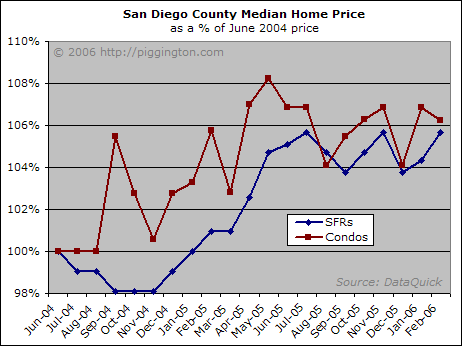
Price breadth was similarly uninformative. There were no big changes either in the number of zip codes with year-over-year appreciation or the number with 5%-or-more depreciation:
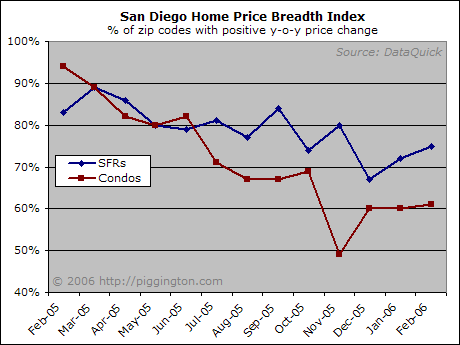
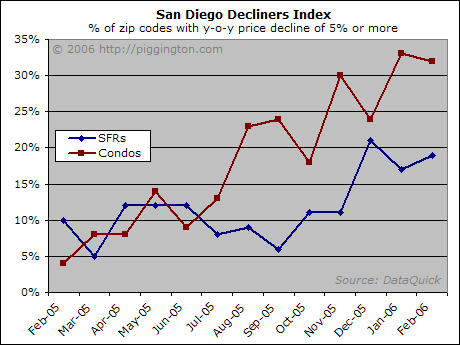
There have been some very interesting discussions in the forums recently as to the value of the median price in determining what’s really going on in the markets. (One such example can be found here.) The median price definitely has some shortcomings as an analytical tool, the most glaring being that it fails to account for the location or quality of homes being bought. This could come into play if a bunch of cheap condo conversions are sold (bringing down the median) or if more new and swanky McMansions are sold (bringing it up). It could also reflect a change in the location of homes being sold… if La Jolla starts selling like hotcakes, the median will move up.
The median could even fail to register a change in the type of buyer doing the purchasing. As the forum topic referenced above discusses, a local real estate agent is contending that very few entry level buyers are buying anymore. This has the short-term effect of bringing the median up, as fewer low-end units are sold. But without buyers entering at the bottom level, the move-up gravy train will screech to a halt. This could be going on right now… and if it is, the median price comparisons would completely overlook it.
When it comes down to it, the main issue is that the median does not measure the value of a given house. And that’s what matters, because that’s what will determine whether people are making or losing money in the market.
All of that said, the median price is still a valuable tool. It may miss some nuances and have some lags, but it certainly gives a good flavor for the directional trend taking place in the market, especially in the longer term. And more to the point, we work with what we have—and the median price is the figure that we can reliably get our hands on every month. Furthermore, by combining the median with other indicators (inventory, sales volume, interest rates, divergence in median price changes by zip code, and more) we are able to use all these relatively blunt instruments to get a much more detailed idea of what’s afoot than any of them could have provided originally.
So while I will always continue looking for ways to refine the available data and to make it as useful as possible, the median price is of some use, and I think we have been pretty successful in combining it with the other available data to get an idea of where the market stands.
Volume
As we’ve come to expect, volume was way down year-over-year, especially for condos:
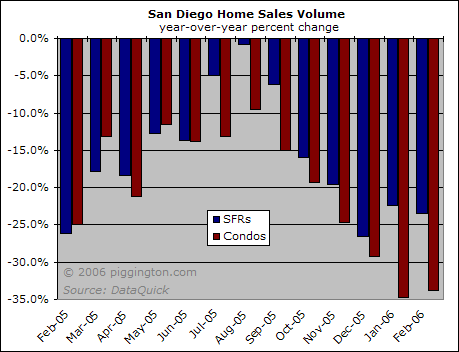
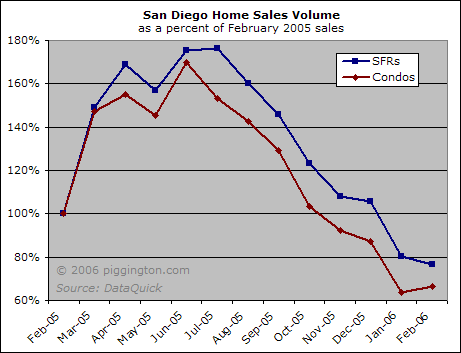
Here’s a longer-term picture… if there’s a trend here, it’s pretty clear which direction it’s going:
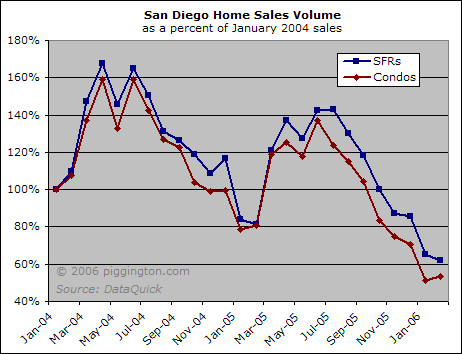
Volume is important because it is an indication of demand for homes. It’s also important because all those real estate transaction fees inject a lot of money into the economy. A trend of declining volume is a warning flag for housing, but it obviously takes quite some time before it translates to lower prices.
Inventory
We also got the expected rise in inventory, which is now up 87% over this time last year:
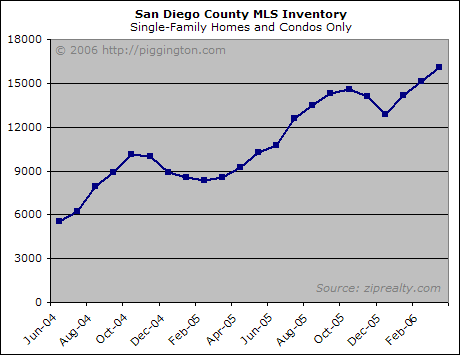
Downtown inventory is up 147% over this time last year:
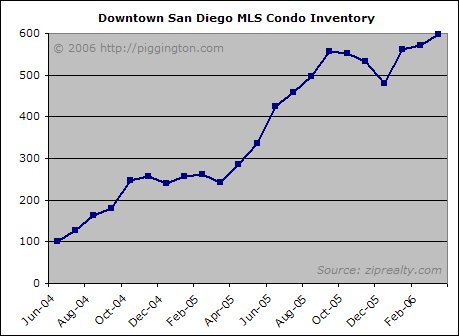
The number of months worth of inventory is actually down from last month, which is expected because of the seasonally low volume in February. Nonetheless, the months-of-inventory figures remain fairly high:
|
Property Type
|
Months of Inventory
|
|
SFR, SD County
|
4.9
|
|
Condo, SD County
|
7.5
|
|
Condo, Downtown SD
|
10.7
|
To put this in perspective, 6 months worth of inventory is considered a "buyers market."
Conclusion
The housing market did not provide us with a lot of additional clues this past month. The trends which had been in place one month prior pretty much continued uninterrupted, and that was that.
Things will now get a lot more interesting. The bulls have been hanging their hats on the spring rally, but I have serious doubts about whether a meaningful spring rally will take place. Last year’s spring rally was fairly weak, and inventory has almost doubled since that time against a steep decline in volume. More importantly, ARM rates have increased substantially and thus decreased the purchasing power of a given monthly payment. I’m just not seeing a big rally in the cards. One thing to note: if there is not a rally, year-over-year median price comparisons will start going negative within a couple of months. This fact would certainly be publicized by the media and sentiment could really start to turn around at that point.
But let’s not get ahead of ourselves. The spring rally sure seems unlikely but we won’t know anything for certain until the data comes in. Stand by…
